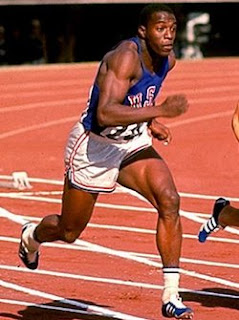The 1964 Tokyo Olympics were the first Summer Olympic Games that I can remember (although they were held in October). Names like Billy Mills and Bob Hayes first entered my awareness. This interesting book with a rather overblown title by journalist and author Roy Tomizawa, places those Olympic Games within the context of Japan's rise from World War II defeat 19 years before. Tomizawa sets the scene very adroitly and fills his chapters with vignettes about various participants and their stories. One of the most interesting pertains to Yoshinori Sakai, who is pictured at right carrying the Olympic flame into the stadium. He was born in Hiroshima on the day the atomic bomb was dropped in 1945 and was dubbed "Atomic Bomb Boy" by the press. His presence caused some discomfort to the Americans and was viewed as a surprisingly bold move by the Japanese organizers.
There are other brief discussions pertaining to aspects of Japanese culture that had arisen following the war such as the Godzilla movies and songs like the misnamed Sukiyaki, which was a hit in the US, and Konichiwa Akachan.
And then there were the athletic events, some of which brought disappointment to the Japanese, such as the defeat of Akio Kaminaga in the open weight judo final by Dutchman Anton Geesink.
There was also the triumph of the Japanese women's volleyball team, pictured below with their controversial hard-driving coach Hirobumi Daimatsu, a veteran of World War II who was criticized for his harsh methods in molding the so-called "Oriental Witches" (not a name that would be considered appropriate today) to championship form.
The book isn't exclusively about the Japanese, who were very eager to please as they hosted the games, and drew praise for their hospitality. There is also the story of Australian swimming legend Dawn Fraser (pictured below), who overcame personal tragedy to add to her collection of medals earned at Melbourne in 1956 and Rome in 1960.
And there was Ethiopian Abebe Bikila, who had won the 1960 Olympic marathon (a male-only event at that time) running barefoot through the streets of Rome, and repeated as marathon champion in Tokyo while shod (pictured below).
The battle in the marathon was for silver, where Japan's Kokichi Tsuburaya (#77 below) was overtaken by Britain's Basil Heatley (#8, on the right) in the final stretch, which proved to be another disappointment for the host country.
There was also American swimmer Dick Roth (pictured below) who battled an attack of appendicitis (he chose to delay surgery so he could compete) to win the men's 400-meter medley event in record time.
Native American runner Billy Mills (pictured below) pulled off a stunning upset to win gold in the men's 10,000 meter race. Mills had a difficult road to Olympic glory and his story is one of perseverance and triumph over prejudice.
It was no upset when American sprinter Bob Hayes (pictured below) won gold in the men's 100-meter race in world record time. The interesting part of the story is that he was wearing borrowed shoes. He was back in his own shoes when he won a second gold medal as anchor of the men's 4X100-meter relay team. "The World's Fastest Human" went on to become a star wide receiver with the NFL's Dallas Cowboys.
There are other stories of victory, defeat, and human drama recounted concisely and interestingly throughout this book. There is also a good discussion of the Paralympics and how those held in 1964 had a positive effect on attitudes toward disabled people in Japan. It is very worthwhile reading for sports fans, like me, who enjoy the Olympics. But there is plenty of material that readers less interested in sports can enjoy.

















